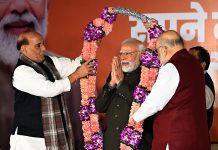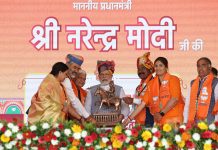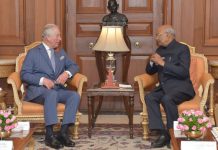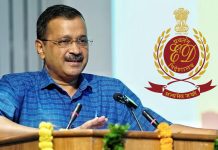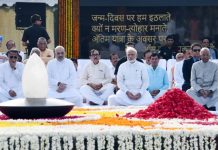
Ahead of Diwali, Christmas and New Year celebrations in the country, a social media campaign is on in a big way against ‘Made in China’ goods. #BoycottChina, #BoycottChineseproducts have trended on Twitter recently. Please pledge “This Diwali we will only buy Indian, regardless of price and not Chinese,” was tweeted from the handle Fearless Hindu.
In the midst of such a movement sweeping the length and breadth of our country, India hosted a summit of BRICS countries amidst a prickly domestic mood at Goa on October 15 and 16 because China was one of the invitees. This apparently did not augur well for the possible interaction between Indian Prime Minister, Narendra Modi and Chinese President Xi Jinping. Water has always been a very emotional issue in India, and China has committed the folly of blocking the flow of river waters to our country.
Little doubt that social media is abuzz with calls for boycotting Chinese goods as punishment for backing Pakistan. The reason is China’s continued support for Pakistan and its voting against Indian interests in the United Nations. China’s shielding Jaish-e-Mohammad head Masood Azhar has also not gone down well with people. The campaign against Chinese goods is an indication of a new moment sweeping the nation in the aftermath of attack on Uri Arm base and subsequent surgical strikes by Indian Army on Pakistan launch pads.
What triggered the boycott
Mohan Bhagwat, the RSS Chief has openly declared the need for boycott of Chinese goods “We speak about self-dependence and standing up to China. The government seems to be standing up to it. But where will the government draw strength from if we don’t stop buying things from China”. This led to a campaign of sorts against Chinese goods coming to India.
However, the campaign went into a frenzy after an allegedly fake letter which was claimed to be signed by none other than Prime Minister Narendra Modi urging the Indian consumers to use ‘swadeshi’ products during Diwali and repulse Chinese goods. The letter became viral on social media platform. The fake letter was circulated all over social media sites like Facebook and Twitter, and also on WhatsApp. The Prime Minister’s Office, however, was quick to contest the veracity of the letter and in a
tweet clarified that the document was not authentic.
What added fuel to the fire was the dormant anger against China for blocking India’s bid to join Nuclear Supplier Group. Also China is viewed as a major road block by Indians towards her permanent seat in United Nations Security Council. In the aftermath of Uri terror attack, China provided Pakistan unconditional support in many international stages. How China is going against can be understood from the fact that China made a large quantum of investments in Pakistan and Pakistan occupied Kashmir.
How China is benefiting from India
Though there are many countries that have trade partner relations with India but it is China which is the largest trade partner of India.
Over sixth of India’s total imports are from China. Another disturbing factor is that while import from China had been growing at 20 per cent over the years, the Indian exports have been witnessing a slide during the corresponding period due to various factors including fall in global crude prices.
Boycott impact on China
India is a huge market of Chinese items as they are cheaper and easily available everywhere. Cellphones, laptops, solar cells, fertilizers, keyboards, displays and communication equipment are India’s chief imports from China, according to our analysis of Ministry of Commerce data. Other major imports from China include tuberculosis and leprosy drugs, antibiotics, children’s toys, industrial springs, ball bearings, LCD and LED displays, routers, TV remote controllers and set top boxes.
The campaign against Chinese goods is an indication of a new moment sweeping the nation in the aftermath of attack on Uri Arm base and subsequent surgical strikes by Indian Army on Pak launch pads
The most alarming impact of Chinese goods on Indian industry has been observed in the Indian toys industry. The industry body, the Associated Chambers of Commerce and Industry of India (ASSOCHAM) study says that 40% of Indian toy companies have closed down in the last five years and rest 20% on the verge of collapse as Chinese products are flooding into Indian market, the biggest threat to the Indian toy industry, reveals the ASSOCHAM study. China has the largest toy market in the world and it accounts for more than 45 percent in the World’s toy market whereas India’s Toy Industry has a meager share of 0.51 percent, reveals the study “Indian Toy Industry- the current scenario”. It says that “Only 20 per cent of the Indian market is served by Indian manufacturers and rest by import of toys from different countries mainly from China and Italy. According to the study, it is found that nearly 40% of toy companies have already closed down”, according to D S Rawat, Secretary General ASSOCHAM. Around 50% of the toy units are in Delhi and NCR, 35% are in Maharashtra while the remaining 15% are scattered all over the country. The toy industry in India is concentrated mainly in the small and cottage sectors, with about 4000 manufacturers in all, adds the study. The Assocham study says that the biggest threat to the Indian toy industry is the competition faced by the Chinese products which offer a wide variety of toys to the people in India and are also available at cheaper prices. The Indian market is flooded with Chinese toys which are destroying the Indian toys industry and small & medium toy manufacturers are almost on the verge of collapse.
According to the study, Indian toy industry is estimated to be around Rs 8,000 crore and is expected to grow at 30% by 2016-17 because of the rising demand of toys by the middle class population spending huge amounts for their children. Indian toy manufacturers are facing difficulty in surviving in the market. Nearly 2,000 SMEs have closed so far in the last 4-5 years with the rise in imports from China & Italy. The manufacturers mainly from Allahabad, Delhi, Kanpur, Lucknow and Patna have closed down, added Rawat. The Chinese goods offer a wide variety at a cheaper price and attract the children of all ages, the wide range like fun games, electronic toys, board games, construction toys, stuffed toys, educational games, toy cars, etc. Currently, the industry employs around 30 lakh people both in the organized and unorganized sector. With the industry growing, employment opportunities are also expected to accelerate. ASSOCHAM study anticipates the employment to be around 50 lakh by 2016-17 with the industry growing at 30%. Small toy shops cater to the masses, while branded ones like FisherPrice, Funskool, Hamleys, Lego and Mattel cater to the middle and high-class. Some large MNC toy manufacturing units like Mattel and Funskool have their presence in India. Funskool Toys is the largest toy producer in India. With hash tags like #BoycottChina and #BoycottChinese products trending on Twitter and patriotism.
letters@tehelka.com


